Since earning my amateur radio license nearly two years ago, I have operated on VHF and UHF a modest amount, mostly participating in weekly Radio ‘Nets, CERT (aka “passing out brochures for emergency planning”), a day of Cascadia Rising and some experiments with packet radio.
With the approaching of ARRL’s Field Day, aka “It’s officially not a numbers contest, but it totally is*” I was interested in trying to get my HF radio set up so I could listen in. I’d also signed up for a late-night slot with the Radio Club of Redmond to give it a whirl.
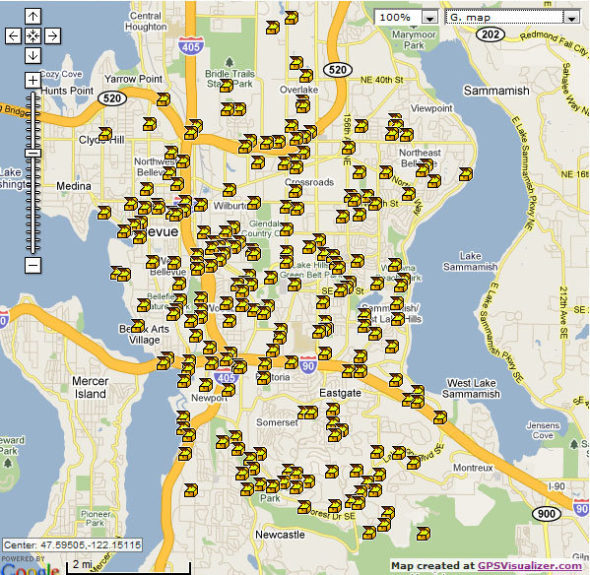
*For the hams who think I’m being harsh in my description of Field Day, Geocaching has the same concepts. Cache Machines run quarterly, offering hordes an organized itinerary to find ~100 caches in a day; challenge caches are different levels of repetitive stress injury :), power trails spam lonely roads but can bolster caching stats; and there are also those who solve a few thousand geocaching puzzles they probably won’t ever go out and find.
And so does cycling. Seattle to Portland is totally a not a race race, replete with pacelines, semi-professional training options and a timing chip.
I get it. It’s one way people enjoy their game.
Anyway… my initial challenge was how to string up a long-enough antenna. Most hams do this by building an antenna gun, which is typically an apparatus made from PVC pipe that pneumatically shoots tennis balls (with strings attached). I was nervous about the percussion calling undue attention to this and reasoned arborists must have to do this sort of thing all the time, so maybe there was a special tool to help out.
Thank you, Internet. With a throw weight and my fine “I analyze data for a living” physique, I was able to toss one up to about 25′ up with a string, but without any semblance of accuracy. The little portable wrist sling shots were very chintzy looking, certainly not going to toss a 400-gram weight up further than I can barely throw it. Enter the industrial sling shot:
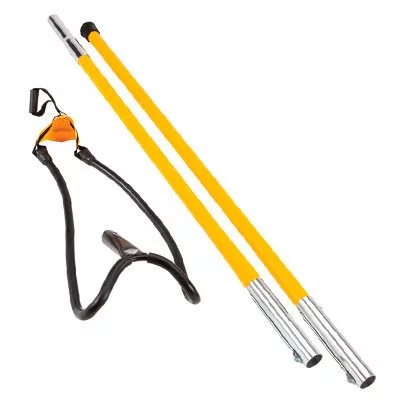
It took me several tries to get the process down: place the weight in the basket, remember to spool out string (rather than entangling around my legs), pull pretty hard and steady, while aiming at the same time. Also: do not try to pull antenna wire directly, dumbass, use twine only. By the seventh shot, I had hurled a throw weight into a beautiful arc around a branch about 75-80 feet up. I replaced the neon-line (good for placing, not good for staying there without raising questions) with black paracord. Oh boy, was this going to be awesome…
… except I could not hear anything on my radio. Granted, I’ve never really used it before, but FFS, surely I can tune it. I borrowed a software-defined radio to look at the spectrum. Wire fine, re-read manuals galore. Finally, I popped open the pre-built balun and found the problem:
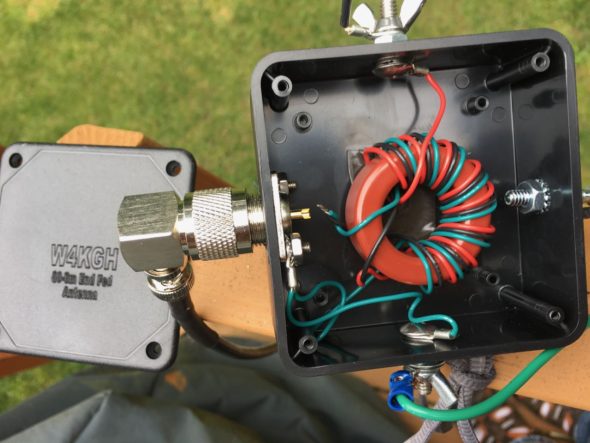
This box is a 9:1 balun, which is simply something “you connect an antenna to.” Signal wasn’t coming in because … the connection to the antenna hadn’t been soldered. While it was countless hours of wasted time looking at other solutions, it was at least a problem I could solve!
So Field Day passed, but I still celebrated my July 4th by getting WSPR (weak signal propagation reporter) working. WSPR nodes are low-powered transmissions followed by listening (typically 1:4 ratio) to gauge radio propagation. Results are sent to a central web site like WSPRNet or PSKReporter. When propagation is really good, amateur radio people are known to drop what they’re doing and run to the shack to work the radio for real.
This is not entirely like geocachers with a potential first to find.
By the end of the week, I had hit five continents from my cookie-cutter subdivision, using only 2 watts of power (albeit, for one-minute polling intervals):
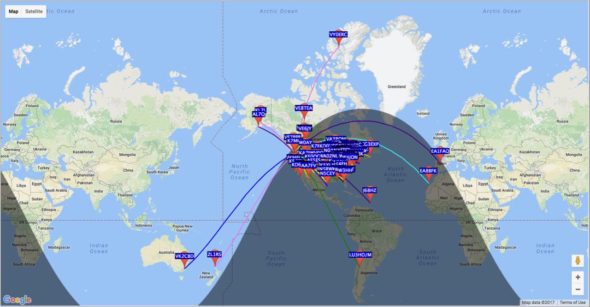
My setup:
- Elecraft KX3 transceiver
- Macbook
- WSJTx software
- USB sound card (this)
- End-fed antenna – 54′ wire, launched into a tree, counterpoise
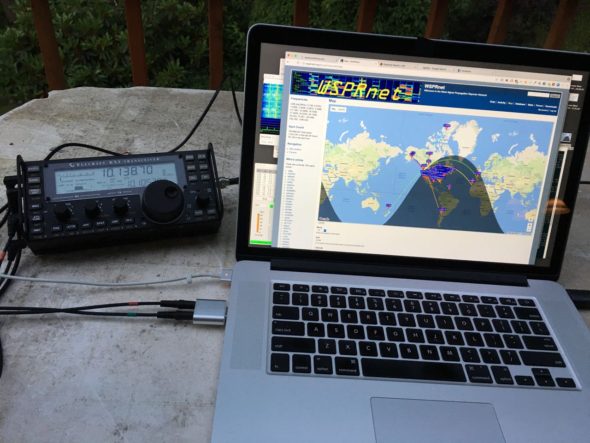
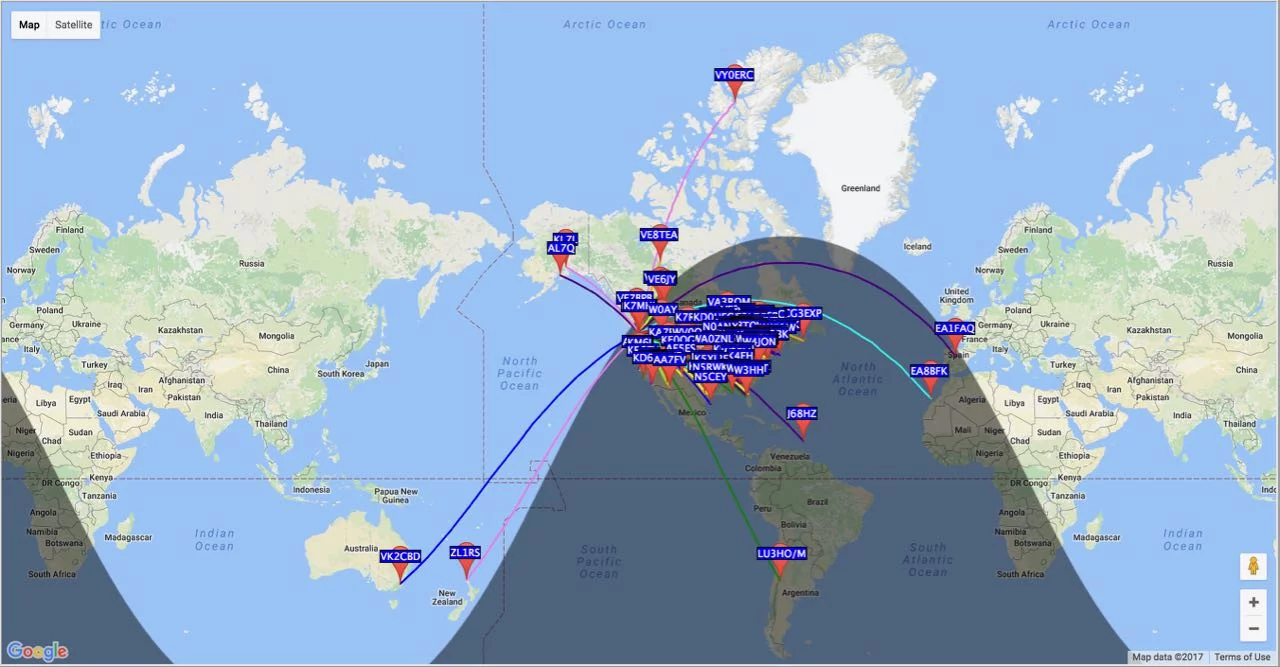
Elecraft? oooo. I have a Ultimate3S kit to assemble when I get home, mostly because I’m interested in using the beacon networks like you are. I’ll probably have to upgrade to general since tech is limited in the HF bands, but hey, it’s a start.
You should definitely upgrade for the added HF bands. I put off getting on HF for a long time, but now that I’m starting to tinker, I’m finding the propagation to be sufficiently challenging and interesting.
Those look like cool kits – I like the idea of a low-power, low-cost beacon system.
The kx3 has been a neat little radio: things just seem to work. I’ve been playing with the FT8 digital mode a lot lately – it’s like JT65/9, but sped up 4x. I think you’d enjoy the pace of it. I am on the hook to provide a tutorial for our local ham group, so I’ll blog about it soon.
it’s just soooo expensive. $1500 plus antenna (for radio+panadapter). Curious about two uses though: bike mobile (aside from antenna, how much ‘stuff’ is there to pack?) and remote operation (same LAN).
oh- and yeah, I’m really interested in propagation and digital modes. LMK if you are headed this way (er, to PDX) and I’ll do the same next time I’m headed up- I’d love to get a demo.
Definitely!
I’ve not taken it bike mobile. THis guy: http://wd8rif.com/kx3_travel_kit.htm specifies what his kit looks like.
If you’re doing voice, there’d be the radio, microphone, earbuds/headphones (because the speaker kinda sucks), antenna and battery pack. Inside, it’ll use 8 NiMH AAs (like eneloops) or you can use an external pack. There’s a whole slew of additional things you can do to reduce power consumption (no backlight, transmit at 3W, etc).
For digital, replace the microphone with a USB cable (supplied with radio) for control and a mic/phone cord for sound. (I don’t have MIC in, so I use a USB dongle on my laptop)
For remote operation, there’s this: http://www.wizkers.io/wizkersradio/
You could go even smaller with a KX2, which forgoes two bands (160M — which is kind of useless to me — and 6M) and gives up the I/Q output for a panadapter, but is a smaller & cheaper package.
Here’s the KX3 vs KX2 comparison: http://www.elecraft.com/manual/KX2%20FAQ%20v-1-1a.pdf